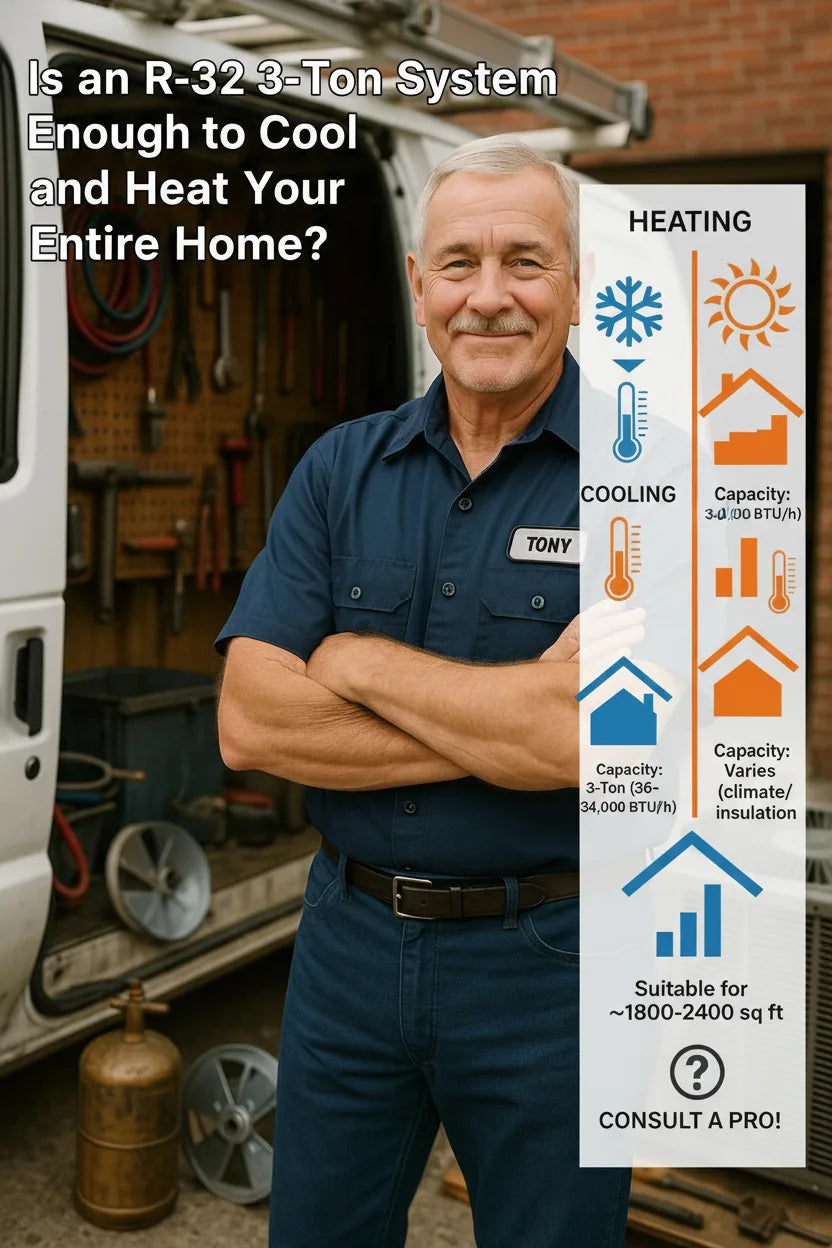Understanding What “3-Ton” Really Means
When HVAC professionals say an air conditioner is 3 tons, they’re not talking about its weight—they’re referring to its cooling capacity.
-
1 ton of cooling = 12,000 BTUs per hour
-
Therefore, a 3-ton system = 36,000 BTUs per hour
In simple terms, your R-32 3-ton system can remove 36,000 BTUs of heat per hour from your home. Whether that’s enough depends on your square footage, insulation quality, and regional climate.
Typical Home Size for a 3-Ton System
A 3-ton R-32 AC is generally suitable for homes ranging from:
-
1,500 to 2,000 square feet in moderate climates
-
1,200 to 1,600 square feet in hotter regions
-
Up to 2,200 square feet in cooler, well-insulated homes
However, this is a starting point—you’ll also need to consider layout, insulation, and other efficiency factors.
Cooling Capacity: How R-32 Makes a Difference
The R-32 refrigerant enhances cooling efficiency thanks to its superior heat transfer properties. Compared to older refrigerants like R-410A, R-32 absorbs and releases heat more effectively, which improves overall performance and reduces energy use.
Advantages of R-32 for Cooling
-
Higher Efficiency – R-32 systems can deliver more cooling power with less refrigerant.
-
Faster Temperature Pull-Down – Rooms reach the desired temperature more quickly.
-
Better Performance in High Heat – R-32 handles higher outdoor temperatures more efficiently, ideal for regions with long, hot summers.
For Tony’s home, this means the R-32 3-ton system may cover more square footage than older refrigerant systems of the same size.
Heating Performance: Can R-32 Handle the Cold?
In addition to cooling, many R-32 systems come with heat pump capabilities, meaning they can both cool in summer and heat in winter. Heat pumps transfer heat energy rather than generate it, making them highly efficient.
How R-32 Heat Pumps Improve Heating Efficiency
-
R-32 performs better in low temperatures than R-410A, allowing the system to continue heating even when outdoor temperatures drop close to freezing.
-
Systems with inverter technology automatically adjust compressor speed to maintain steady indoor temperatures, reducing energy waste.
However, for homes in regions with very cold winters (below 20°F), Tony may need:
-
An auxiliary electric heater for backup warmth.
In most temperate to moderately cold climates, a 3-ton R-32 system can comfortably handle both cooling and heating all year round.
Home Layout and Insulation Matter
Even the most powerful system can struggle if your home isn’t properly insulated or has inefficient air distribution.
Key Factors to Consider
-
Insulation Quality – Well-insulated attics, walls, and windows reduce the load on your HVAC system.
-
Ceiling Height – Higher ceilings increase the air volume, requiring more BTUs.
-
Windows and Sun Exposure – South- and west-facing rooms absorb more heat and may need additional cooling capacity.
-
Room Distribution – Open-concept homes distribute air more easily, while multi-room layouts may require zoning or duct adjustments.
Tony’s home might need a zoned duct system if it has multiple stories or separate wings. This allows the R-32 system to cool and heat different areas efficiently without overworking.
Climate and Regional Considerations
Your local climate plays a major role in determining if a 3-ton R-32 system is sufficient:
-
Hot & Humid Areas (e.g., Florida, Texas) – You may need additional capacity or dehumidification features to maintain comfort.
-
Moderate Climates (e.g., Tennessee, North Carolina) – A 3-ton R-32 system is ideal for most average-sized homes.
-
Cold Regions (e.g., Minnesota, Maine) – Consider pairing the R-32 system with a gas furnace or supplemental heating source for full winter coverage.
R-32’s improved low-temperature performance still makes it more effective than older systems in handling seasonal variations.
When to Upgrade to a Larger System (or Add Zones)
If your home is larger than 2,000 square feet or has multiple stories, a single 3-ton unit might not be enough to maintain consistent comfort in every room.
Options for Larger Homes
-
Dual-Zone System:
Add a second air handler or zone controller to split your home into two temperature zones. -
4-Ton R-32 System:
Upgrade to a higher-capacity unit for better coverage if your home exceeds 2,000–2,200 square feet. -
Supplemental Cooling:
Install smaller through-the-wall or mini-split units for problem areas like sunrooms or upstairs bedrooms.
Zoning and proper duct design often make more difference than sheer tonnage when it comes to whole-home comfort.
Energy Efficiency and Long-Term Savings
R-32 systems are not just powerful—they’re designed to save energy.
Why R-32 Systems Are Cost-Efficient
-
Higher SEER2 Ratings: Many 3-ton R-32 systems achieve 15–17 SEER2, well above federal minimums.
-
Reduced Energy Waste: Inverter-driven compressors adapt to demand, avoiding frequent start-stop cycles.
-
Lower Utility Bills: Homeowners typically save 10–20% on energy costs compared to R-410A systems.
Over 10 years, Tony could save hundreds—if not thousands—on energy bills simply by choosing R-32.
Quick Reference: Is a 3-Ton R-32 System Enough for You?
| Home Size (sq ft) | Climate | Recommendation |
|---|---|---|
| 1,200 – 1,600 | Hot | Possibly; may need zoning or shade optimization |
| 1,500 – 2,000 | Moderate | ✅ Excellent fit |
| 1,800 – 2,200 | Cool | ✅ Works efficiently |
| 2,200+ | Any | Consider 4-ton or zoned setup |
Conclusion: Finding the Perfect Fit for Your Home
So, is an R-32 3-Ton system enough to cool and heat your entire home?
For most mid-sized, well-insulated homes (1,500–2,000 sq. ft.), the answer is yes. R-32 technology offers superior cooling, improved efficiency, and better low-temperature performance—making it ideal for all-season comfort.
However, if Tony’s home has unique challenges like poor insulation, multiple floors, or extreme climate conditions, a zoned system or slightly larger capacity might be the smarter choice.
With the right setup, an R-32 3-ton unit can provide reliable, efficient comfort while keeping energy costs low for years to come.
In the next topic we will know more about: The Benefits of Combining R-32 AC with a Gas Furnace: Tony’s Complete Guide







